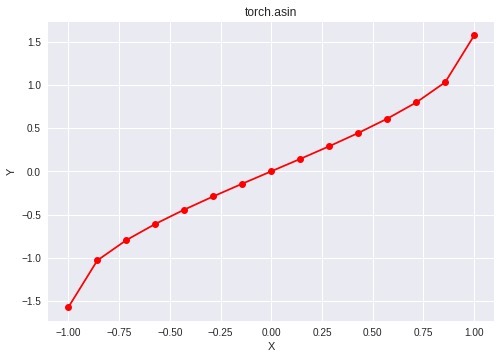PyTorch是由Facebook開發的開源機器學習庫。它用於深度神經網絡和自然語言處理。
函數torch.asin()為PyTorch中的反正弦函數提供支持。它期望輸入在[-1,1]範圍內,並以弧度形式給出輸出。如果輸入不在[-1,1]範圍內,則返回nan。輸入類型為張量,如果輸入包含多個元素,則將計算按元素的反正弦值。
用法: torch.asin(x, out=None)
參數:
x:輸入張量
name(可選):輸出張量
返回類型:與x具有相同類型的張量。
代碼1:
# Importing the PyTorch library
import torch
# A constant tensor of size 6
a = torch.FloatTensor([1.0, -0.5, 3.4, 0.2, 0.0, -2])
print(a)
# Applying the inverse sin function and
# storing the result in 'b'
b = torch.asin(a)
print(b)輸出:
tensor([ 1.0000, -0.5000, 3.4000, 0.2000, 0.0000, -2.0000]) tensor([ 1.5708, -0.5236, nan, 0.2014, 0.0000, nan])
代碼2:可視化
# Importing the PyTorch library
import torch
# Importing the NumPy library
import numpy as np
# Importing the matplotlib.pylot function
import matplotlib.pyplot as plt
# A vector of size 15 with values from -1 to 1
a = np.linspace(-1, 1, 15)
# Applying the inverse sine function and
# storing the result in 'b'
b = torch.asin(torch.FloatTensor(a))
print(b)
# Plotting
plt.plot(a, b.numpy(), color = 'red', marker = "o")
plt.title("torch.asin")
plt.xlabel("X")
plt.ylabel("Y")
plt.show()輸出:
tensor([-1.5708, -1.0297, -0.7956, -0.6082, -0.4429, -0.2898, -0.1433, 0.0000,
0.1433, 0.2898, 0.4429, 0.6082, 0.7956, 1.0297, 1.5708])

相關用法
- Python PyTorch tan()用法及代碼示例
- Python PyTorch sin()用法及代碼示例
- Python PyTorch cos()用法及代碼示例
- Python PyTorch cosh()用法及代碼示例
- Python PyTorch tanh()用法及代碼示例
- Python PyTorch sinh()用法及代碼示例
- Python PyTorch acos()用法及代碼示例
- Python PyTorch atan()用法及代碼示例
- Python sympy.asin()用法及代碼示例
- Python Tensorflow asin()用法及代碼示例
- Python next()用法及代碼示例
注:本文由純淨天空篩選整理自vaibhav29498大神的英文原創作品 Python | PyTorch asin() method。非經特殊聲明,原始代碼版權歸原作者所有,本譯文未經允許或授權,請勿轉載或複製。
